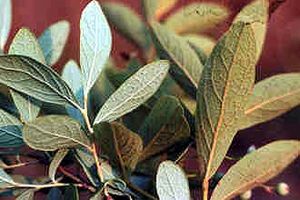Dangleberry facts for kids
Quick facts for kids Dangleberry |
|
|---|---|
 |
|
| Conservation status | |
| Scientific classification | |
| Genus: |
Gaylussacia
|
| Species: |
frondosa
|
| Synonyms | |
Gaylussacia frondosa is a cool plant often called the dangleberry or blue huckleberry. It's part of the heath family, which also includes blueberries! You can find this plant growing naturally in the eastern parts of the United States. It stretches from New Hampshire all the way down to South Carolina.
Contents
What is a Dangleberry Plant Like?
This plant is a shrub, which means it's a woody plant smaller than a tree. It can grow up to two meters (about 80 inches) tall. That's taller than most kids!
The dangleberry plant spreads out using special underground stems called rhizomes. These rhizomes help new stems sprout up. This way, the plant can form large groups or "colonies."
Its leaves can be up to 6 centimeters (2.4 inches) long. They are also about 3 centimeters (1.2 inches) wide. The leaves feel a bit hairy and have tiny glands on them.
Flowers and Fruit
The plant's flowers grow in clusters called an inflorescence. Each cluster usually has 1 to 4 flowers. These flowers hang down on thin stalks called pedicels, which can be up to 2 centimeters (0.8 inch) long.
The flowers themselves are shaped like tiny bells. They are usually a greenish-white color. After the flowers bloom, they turn into fruit.
The fruit is a juicy, sweet-tasting drupe. A drupe is a type of fruit with a hard pit or seed inside, like a peach or cherry. Dangleberries are usually blue, but sometimes they can be black or even white.
Where Do Dangleberries Grow?
You can find dangleberry plants growing on the Atlantic coastal plain. This is the flat land along the Atlantic Ocean. They like to grow in wooded areas.
They also grow near wet places like bogs and swamps. They are very common in the pine barrens of New Jersey.
Dangleberries prefer soils that are acidic. This means the soil has a low pH. They also like soils that don't have a lot of nutrients.
Plant Neighbors
Dangleberries often grow alongside other interesting plants. These include other plants from the heath family. Some of their plant neighbors are:
- Highbush blueberry (Vaccinium corymbosum)
- Hillside blueberry (V. pallidum)
- Different kinds of Lyonia plants
- Sheep-laurel (Kalmia angustifolia)
- Wintergreen (Gaultheria procumbens)
- Dwarf huckleberry (Gaylussacia dumosa)
- Black huckleberry (G. baccata)
Who Eats Dangleberries?
Many different animals love to eat the sweet dangleberry fruits. When animals eat the berries, they also help the plant. They spread the seeds around when they move. This is called seed dispersal. It helps new dangleberry plants grow in different places.
How Scientists Classify Dangleberries
Scientists classify plants to understand them better. Gaylussacia frondosa was once thought to include more types of plants. These were called "varieties."
However, scientists now recognize two of these varieties as their own separate species. These are Gaylussacia nana and Gaylussacia tomentosa. This means they are now seen as distinct kinds of dangleberries.


